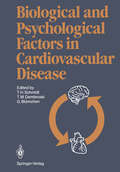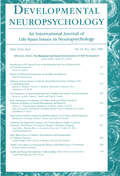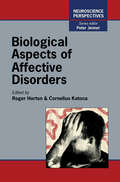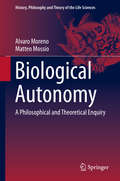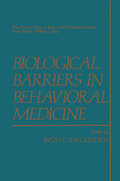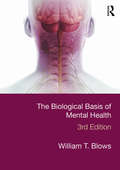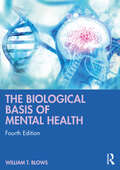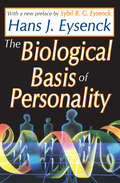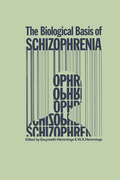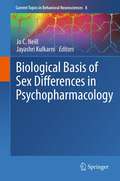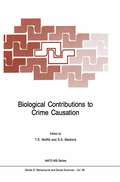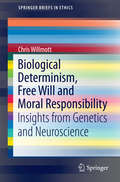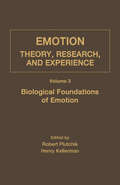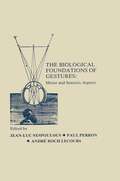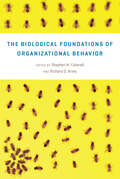- Table View
- List View
Biological and Psychological Factors in Cardiovascular Disease
by GerhardBlümchen Theodore M.Dembroski Thomas H. SchmidtAn opening address should ask the right questions, which we expect to answer during the coming years. A good opening address should formu late hypotheses for falsification during the conference or in the near fu ture. Mter Dr. Groen's excellent lecture yesterday, I feel better about my task, because I feel I am not alone in asking the ten questions in my ab stract. It is an honor for me to give this short paper largely based on my expe riences during 15 years as medical director of a rehabilitation center in Ba varia, as a teacher at two medical schools in Munich and Innsbruck, and as an old-fashioned holistic cardiologist. However, it also is a difficult task for me because the subject of this conference concerning biobehavioral factors in coronary heart disease is controversial, not only in the medical society, but in my own mind as well. When I organized one of the first conferences on stress and coronary heart disease in West Germany in 1976, followed by conferences in 1979 and 1980, the semantic problems between physicians and psychologists were very significant. However, communication has improved in this area during the last decade. The most encouraging event in this field was a sym posium in May 1984 in Rotenburg/Fulda on the topic "Return to Work af ter Bypass Surgery", organized by a cardiac surgeon, Dr. Walter.
The Biological and Social Determinants of Child Development: A Special Double Issue of developmental Neuropsychology
by Steven M. LeharThe Biological and Social Determinants of Child Development stimulates cross-disciplinary communication and research collaboration in the field of child development. While the papers in this issue seem diverse in terms of topic and discipline, there are a number of common themes: *critical period for brain development and the importance of specific environmental input during this period; *importance of early brain development and enriched environments is supported in articles describing findings from human studies; *potential for brain plasticity following specialized retraining is found in a compelling paper demonstrating different profiles of brain activation for normal readers vs. those who have dyslexia and younger children at high risk for development of reading disabilities; and *critical period, brain plasticity, and parallel changes in developing behavior and brain structure and functioning. As a number of papers in this issue describe potential interventions, one is relevant because it describes the numerous factors that make results of such studies have the potential to generalize to larger populations. Putting the described papers in a broad perspective, the last article argues that we cannot understand the health status of a society without understanding the health-determining influences across the life course.
The Biological and Social Determinants of Child Development: A Special Double Issue of developmental Neuropsychology
by Steven M. LeharThe Biological and Social Determinants of Child Development stimulates cross-disciplinary communication and research collaboration in the field of child development. While the papers in this issue seem diverse in terms of topic and discipline, there are a number of common themes: *critical period for brain development and the importance of specific environmental input during this period; *importance of early brain development and enriched environments is supported in articles describing findings from human studies; *potential for brain plasticity following specialized retraining is found in a compelling paper demonstrating different profiles of brain activation for normal readers vs. those who have dyslexia and younger children at high risk for development of reading disabilities; and *critical period, brain plasticity, and parallel changes in developing behavior and brain structure and functioning. As a number of papers in this issue describe potential interventions, one is relevant because it describes the numerous factors that make results of such studies have the potential to generalize to larger populations. Putting the described papers in a broad perspective, the last article argues that we cannot understand the health status of a society without understanding the health-determining influences across the life course.
Biological Aspects of Affective Disorders (ISSN)
by Cornelius KatonaBiological research in the affective disorders has been an international growth industry for several years. Biological Aspects of Affective Disorders is a comprehensive introduction to the biochemical, pharmacological, and genetic aspects constituting the abnormalities that may underline the diseases of depression and mania, together with the current understanding of the clinical features and management of affected patients.It will be of great value especially to young researchers from all disciplines contributing to this area and to trainee psychiatrists.
Biological Autonomy: A Philosophical and Theoretical Enquiry (History, Philosophy and Theory of the Life Sciences #12)
by Alvaro Moreno Matteo MossioSince Darwin, Biology has been framed on the idea of evolution by natural selection, which has profoundly influenced the scientific and philosophical comprehension of biological phenomena and of our place in Nature. This book argues that contemporary biology should progress towards and revolve around an even more fundamental idea, that of autonomy. Biological autonomy describes living organisms as organised systems, which are able to self-produce and self-maintain as integrated entities, to establish their own goals and norms, and to promote the conditions of their existence through their interactions with the environment.Topics covered in this book include organisation and biological emergence, organisms, agency, levels of autonomy, cognition, and a look at the historical dimension of autonomy. The current development of scientific investigations on autonomous organisation calls for a theoretical and philosophical analysis. This can contribute to the elaboration of an original understanding of life - including human life - on Earth, opening new perspectives and enabling fecund interactions with other existing theories and approaches. This book takes up the challenge.
Biological Barriers in Behavioral Medicine (The Springer Series in Behavioral Psychophysiology and Medicine)
by Wolfgang Von Der LindenA "New Looking Glass" for Behavioral Medicine In 1984, John Briggs, a science writer and specialist in interdisciplinary studies teaching at the New School for Social Research, and F. David Peat, a physicist who was for many years a fellow with the National Research Council of Canada, published a book about the revolutions that were taking place in physics, mathematics, chemistry, biology, and neu rophysiology and about the scientists whose new theories were changing our understanding about the nature of the universe. The title of their book was Looking Glass Universe, after Lewis Carroll's classic story of Alice and her friends, Through the Looking Glass. Briggs and Peat's book is a well-written, challenging volume about human beings and how they think about old problems in new and sometimes startling ways. I mention Briggs and Peat's book only partially because I happen to have a personal interest in the potential applications of new ways of looking at and thinking about nature and data derived from modern physics and systems theory for health psychology and behavioral medi cine (e. g. , Schwartz, 1984). In a letter Wolfgang Linden wrote to me on January 23,1987, he shared with me (at my request) his rough thoughts about his personal goals for this book.
The Biological Basis of Mental Health
by William T. BlowsThis book explores the underlying biology associated with the pathology of mental health disorders and the related nervous system. Fully revised for this third edition, each chapter has been updated to include the latest research, ideas and concepts in each field, and includes a new chapter on sleep. Integrating up-to-date pharmacological and genetic knowledge with an understanding of environmental factors that impact on human biology, The Biological Basis of Mental Health covers topics including brain development, neural communication, neurotransmitters and receptors, hormones and behaviour, genetic disorders, pharmacology, drug abuse, anxiety, schizophrenia, depression, epilepsy, subcortical degenerative diseases of the brain, dementia, developmental disorders, and sleep. Accessible and engaging, this is an essential text for mental health students, practitioners and educators.
The Biological Basis of Mental Health
by William T. BlowsThis book explores the underlying biology associated with the pathology of mental health disorders and the related nervous system. Fully revised for this third edition, each chapter has been updated to include the latest research, ideas and concepts in each field, and includes a new chapter on sleep. Integrating up-to-date pharmacological and genetic knowledge with an understanding of environmental factors that impact on human biology, The Biological Basis of Mental Health covers topics including brain development, neural communication, neurotransmitters and receptors, hormones and behaviour, genetic disorders, pharmacology, drug abuse, anxiety, schizophrenia, depression, epilepsy, subcortical degenerative diseases of the brain, dementia, developmental disorders, and sleep. Accessible and engaging, this is an essential text for mental health students, practitioners and educators.
The Biological Basis of Mental Health
by William T. BlowsThis book explores the underlying biology and neuroscience associated with mental health and wellbeing. This fully revised fourth edition includes new chapters on behavioural science, and brain-gut and brain-gender connections, as well as expanded content on memory and genetics. Integrating up-to-date pharmacological and genetic research with an understanding of environmental factors that impact on human biology, The Biological Basis of Mental Health covers topics including brain development, neural communication, neurotransmitters and receptors, hormones and behaviour, genetic disorders, pharmacology, substance misuse, anxiety, schizophrenia, depression, epilepsy, subcortical degenerative diseases of the brain, dementia, developmental disorders and sleep. This unique textbook is an essential read for all healthcare students, practitioners and educators with an interest in mental health and neuroscience.
The Biological Basis of Mental Health
by William T. BlowsThis book explores the underlying biology and neuroscience associated with mental health and wellbeing. This fully revised fourth edition includes new chapters on behavioural science, and brain-gut and brain-gender connections, as well as expanded content on memory and genetics. Integrating up-to-date pharmacological and genetic research with an understanding of environmental factors that impact on human biology, The Biological Basis of Mental Health covers topics including brain development, neural communication, neurotransmitters and receptors, hormones and behaviour, genetic disorders, pharmacology, substance misuse, anxiety, schizophrenia, depression, epilepsy, subcortical degenerative diseases of the brain, dementia, developmental disorders and sleep. This unique textbook is an essential read for all healthcare students, practitioners and educators with an interest in mental health and neuroscience.
The Biological Basis of Mental Health Nursing (Second Edition)
by William BlowsWritten by an experienced nurse lecturer who also trained as a mental health nurse, this book explores the underlying biology associated with the pathology of mental health disorders and the related nervous system. Fully revised for this second edition, the text includes three new chapters on brain development,pharmacology and learning, behavioural and developmental disorders. Integrating up-to-date pharmacological and genetic knowledge with an understanding of environmental factors that impact on human biology, The Biological Basis of Mental Health Nursing covers topics including: the physiology of neurotransmission and receptors hormones and mental health the biology of emotions, stress, anxiety and phobic states the biology of substance abuse the pharmacology of psychoactive drugs developmental disorders brain anatomy and development the biology of behaviour genetics and mental health affective disorders: depression, mania and suicide schizophrenia autism and other syndromes the ageing brain and dementia degenerative diseases of the brain epilepsy. Accessibly laid out, with many of diagrams, tables and key points at the end of each chapter, this is an essential text for mental health nursing students, practitioners and educators.
The Biological Basis of Mental Health Nursing (Second Edition) (PDF)
by William BlowsWritten by an experienced nurse lecturer who also trained as a mental health nurse, this book explores the underlying biology associated with the pathology of mental health disorders and the related nervous system. Fully revised for this second edition, the text includes three new chapters on brain development,pharmacology and learning, behavioural and developmental disorders. Integrating up-to-date pharmacological and genetic knowledge with an understanding of environmental factors that impact on human biology, The Biological Basis of Mental Health Nursing covers topics including: the physiology of neurotransmission and receptors hormones and mental health the biology of emotions, stress, anxiety and phobic states the biology of substance abuse the pharmacology of psychoactive drugs developmental disorders brain anatomy and development the biology of behaviour genetics and mental health affective disorders: depression, mania and suicide schizophrenia autism and other syndromes the ageing brain and dementia degenerative diseases of the brain epilepsy. Accessibly laid out, with many of diagrams, tables and key points at the end of each chapter, this is an essential text for mental health nursing students, practitioners and educators.
The Biological Basis of Personality
by Hans EysenckThis classic is one of the most cited and novel approaches to psychology ever written. Hans Eysenck presents a descriptive and causal model of human personality in accord with the major concepts of experimental psychology and the physiological and neurological mechanisms that form the biological basis of behavior patterns. His proposal for an alliance between personality and physiology represented a major innovation in the field of psychology, distinguished his research from his contemporaries, and set the stage for a wealth of research to come. Before this foundational work, Eysenck had initially constructed a model of personality in such works as Dimensions of Personality and The Experimental Study of Personality, but these were primarily descriptive in nature. A second phase of research included his Dynamics of Anxiety and Hysteria and Experiments with Drugs, where he provided causal analysis by reference to concepts then current in experimental psychology. The Biological Basis of Personality represents Eysenck's third phase, when he dug deeper to find biological causes underlying the psychological concepts of emotion, excitation, and inhibition--which had formed the building blocks of his earlier efforts. In this work, the causal links he postulates between personality variables and neurological and physiological discoveries establish a realistic model that takes theory out of the field of mere speculation. As Sybil Eysenck makes clear in her new preface, this book paved the way for a "marriage" of the experimental and individual difference approach in personality psychology. As Sybil Eysenck makes clear in her new preface, this book paved the way for a "marriage" of the experimental and individual difference approach in personality psychology.
The Biological Basis of Personality
by Hans EysenckThis classic is one of the most cited and novel approaches to psychology ever written. Hans Eysenck presents a descriptive and causal model of human personality in accord with the major concepts of experimental psychology and the physiological and neurological mechanisms that form the biological basis of behavior patterns. His proposal for an alliance between personality and physiology represented a major innovation in the field of psychology, distinguished his research from his contemporaries, and set the stage for a wealth of research to come.Before this foundational work, Eysenck had initially constructed a model of personality in such works as Dimensions of Personality and The Experimental Study of Personality, but these were primarily descriptive in nature. A second phase of research included his Dynamics of Anxiety and Hysteria and Experiments with Drugs, where he provided causal analysis by reference to concepts then current in experimental psychology. The Biological Basis of Personality represents Eysenck's third phase, when he dug deeper to find biological causes underlying the psychological concepts of emotion, excitation, and inhibition--which had formed the building blocks of his earlier efforts. In this work, the causal links he postulates between personality variables and neurological and physiological discoveries establish a realistic model that takes theory out of the field of mere speculation.As Sybil Eysenck makes clear in her new preface, this book paved the way for a "marriage" of the experimental and individual difference approach in personality psychology.As Sybil Eysenck makes clear in her new preface, this book paved the way for a "marriage" of the experimental and individual difference approach in personality psychology.
The Biological Basis of Personality
by Hans EysenckThis classic is one of the most cited and novel approaches to psychology ever written. Hans Eysenck presents a descriptive and causal model of human personality in accord with the major concepts of experimental psychology and the physiological and neurological mechanisms that form the biological basis of behavior patterns. His proposal for an alliance between personality and physiology represented a major innovation in the field of psychology, distinguished his research from his contemporaries, and set the stage for a wealth of research to come.Before this foundational work, Eysenck had initially constructed a model of personality in such works as Dimensions of Personality and The Experimental Study of Personality, but these were primarily descriptive in nature. A second phase of research included his Dynamics of Anxiety and Hysteria and Experiments with Drugs, where he provided causal analysis by reference to concepts then current in experimental psychology. The Biological Basis of Personality represents Eysenck's third phase, when he dug deeper to find biological causes underlying the psychological concepts of emotion, excitation, and inhibition--which had formed the building blocks of his earlier efforts. In this work, the causal links he postulates between personality variables and neurological and physiological discoveries establish a realistic model that takes theory out of the field of mere speculation.As Sybil Eysenck makes clear in her new preface, this book paved the way for a "marriage" of the experimental and individual difference approach in personality psychology.As Sybil Eysenck makes clear in her new preface, this book paved the way for a "marriage" of the experimental and individual difference approach in personality psychology.
The Biological Basis of Schizophrenia
by Gwynneth Hemmings W. A. HemmingsFor years lip service has been paid to a belief in a biological basis for schizophrenia, but ,nevertheless psychosocial and psychodynamic "theories" of schizophrenia have been promulgated, and these have detracted from the all important biological work, Eclecticism has ruled the day and has caused considerable confusion, As a result research in schizophrenia has not progressed as fast as it should have done and treatment has been less effective than it could otherwise have been. This book is devoted to a wholly biological approach to the problem of schizophrenia, in the hope that many more workers will enter this exciting field of research. A wide variety of topics is covered, including brain structure; the genetics, pathogenesis and treatment of schizophrenia; a consideration of dietary and immunological factors and finally a chapter on alcoholism as it seems possible that the problems of schizophrenia and addiction are linked. We are grateful to all our contributors and to MTP Press for their enthusiasm for this book. Gwynneth P Hemmings William A Hemmings XI SECTION 1: Structure 1 The brain stem reticular formation K. E. WEBSTER There can be no question that the brain stem reticular lormation no longer exercises the same fascination for neurologists that it did a quarter of a century ago.
Biological Basis of Sex Differences in Psychopharmacology (Current Topics in Behavioral Neurosciences #8)
by Jo C. Neill and Jayashri KulkarniSex matters! Are there differences between the sexes when it comes to brain function and the behaviours that result? This volume attempts to answer this fundamental question. If the answer is ‘yes’ then this should impact upon our approach to treating mental illness in humans, and to modelling it in animals, as we look for aetiological and pharmacological solutions.
Biological Contributions to Crime Causation (NATO Science Series D: #40)
by T. E. Moffitt Sarnoff A. MednickThis book presents reviews of the literature and reports of new findings from research into biological correlates of criminal behavior. The chapters are revised versions of talks given by participants in an Advanced Study Institute sponsored by the North Atlantic Treaty Organization and held inCastelvecchio Pascoli in September, 1986. It is our second edited volume on biology and crime. The first book, The Causes of Cdme; New Biological Apwoaches, was published in 1987. In the preface to that book we described the regrettable hi. tory of the paeudobiological research into social problem. conducted by the Social Darwinists at the turn of the century. We requested that that unfortunate legacy not inhibit responsible and scientifically sound investigations of biological and psychological variables in criminology today. Evidence is mounting that showl that research limited to social and environmental vadables cannot explain the behavior of the minority of criminal offenders whose criminal careen begin in adolescence and develop into recidivistic and violent . . saults on society. Certainly these offenders are few, but epidemiological studies have found them to be responsible for an amount of crimes disproportionate to their small numbers. As few . . 5 % of males commit over 50% of criminal offenses. Intervention directed at these relatively few individuals could, if succes. ful, dramatically reduce our growing violent crime rate. The chapters in our earlier book showed that some biological variables do relate to this type of chronic offending.
Biological Determinants of Reinforcement: Biological Determinates of Reinforcement (Quantitative Analyses of Behavior Series)
by Michael L. Commons Russell M. Church James R. Stellar Allan R. WagnerThis seventh volume, divided into four parts, addresses the biological determinates of reinforcement and memory. Covers topics in electrical brain stimulation, drugs and reinforcement, and cellular mechanisms.
Biological Determinants of Reinforcement: Biological Determinates of Reinforcement (Quantitative Analyses of Behavior Series)
by Michael L. Commons, Russell M. Church, James R. Stellar and Allan R. WagnerThis seventh volume, divided into four parts, addresses the biological determinates of reinforcement and memory. Covers topics in electrical brain stimulation, drugs and reinforcement, and cellular mechanisms.
Biological Determinism, Free Will and Moral Responsibility: Insights from Genetics and Neuroscience (SpringerBriefs in Ethics)
by Chris WillmottThis book examines the way in which new discoveries about genetic and neuroscience are influencing our understanding of human behaviour. As scientists unravel more about the ways in which genes and the environment work together to shape the development of our brains, their studies have importance beyond the narrow confines of the laboratory. This emerging knowledge has implications for our notions of morality and criminal responsibility. The extent to which “biological determinism” can be used as an explanation for our behaviour is of interest to philosophers reflecting on the free will versus determinism debate. It also has repercussions for the criminal justice system; in courtrooms around the world, defence lawyers are beginning to appeal to genetic and brain imaging data as grounds for finding their clients not guilty. Can a defendant’s genes or the structure of his brain be used as an excuse for his behaviour? Is criminality “hardwired”? Is it legitimate to claim “I couldn’t help it, my genes made me do it”? This book appeals to anyone interested in the link between behaviour and genetics, the science and philosophy of moral responsibility and/or criminal law.
Biological Foundations of Emotion
by Robert Plutchik Henry KellermanBiological Foundations of Emotion is a detailed account of the relations between brain structure, functions, and emotions based on the results of experimental work and theoretical modeling. A range of issues are examined, such as whether there are structures, circuits, or biochemical events in the brain that control emotional expressions or experience; the effects of lesions and electrical stimulation on emotions; and the role of genetics in the expression of emotion.Comprised of 16 chapters, this volume begins with a presentation of general models of brain functioning. The first chapter deals with the neural substrate for emotion and cites evidence showing that the conventional concept of a limbic system underlying all emotions is not adequate. The discussion then turns to ethological and evolutionary factors of emotion, with emphasis on neuroendocrine patterns of emotional response; ictal symptoms relating to the nature of affects and their cerebral substrate; the anatomy of emotions; and neural systems involved in emotion in primates. Subsequent chapters present different but overlapping brain models of aggression and examine the role of biochemistry in understanding emotions. This book will be of interest to biologists and psychologists.
The Biological Foundations of Gesture: Motor and Semiotic Aspects (Neuropsychology and Neurolinguistics Series)
by Jean-Luc Nespoulous, Paul Perron and André Roch LecoursFirst published in 1986. Routledge is an imprint of Taylor & Francis, an informa company.
The Biological Foundations of Gesture: Motor and Semiotic Aspects (Neuropsychology and Neurolinguistics Series)
by J. L. Nespoulous P. Perron A. R. LecoursFirst published in 1986. Routledge is an imprint of Taylor & Francis, an informa company.
The Biological Foundations of Organizational Behavior
by Stephen M. Colarelli Richard D. ArveyIn recent years, evolutionary psychology and behavioral genetics have emerged as prominent theoretical perspectives within the social sciences. Yet despite broad levels of commonality between the disciplines—including an emphasis on adaptation, evolved mechanisms that guide behavior, and consequences of mismatch between these mechanisms and novel environments—studies that apply these perspectives on social behavior to organizations remain relatively rare. The Biological Foundations of Organizational Behavior brings together contributors who shed light on the potential that behavioral genetics and evolutionary psychology offer for studies of organizational behavior. In addition to examining the extant literature integrating these disciplines and organizational behavior, the book reconsiders a wide range of topics through the lens of biology within organizational behavior, including decision making, leadership and hierarchy, goals and collective action, and individual difference. Contributions also explore new areas of potential application and provide a critical assessment of the challenges that lie ahead. With accessible insights for scholars and practitioners, The Biological Foundations of Organizational Behavior marks a promising step forward in what is increasingly perceived to be an underdeveloped area of organizational behavior.
